|
Since Zug.com died a rather abrupt
death, I figured I should mirror my work here. Also, this way I
can pretend they're new updates. Excuse the terrible formatting, I
felt like putting in effort to fix it would be an insult to the original
work. Also, I didn't want to put in effort.
As an extremely pale person, I have often required the healing
properties of aloe. It has always been there for me at the end of a long
day involving an "It's not that sunny out" misadventure. Although to be
honest, I don't even know if aloe actually works. All I know is that
when I get burned, I rub some green slime on me, and a few days later
I'm a little better.
Of course, a few days later without aloe would probably also
result in me getting a little better, but then I wouldn't get to
experience the feeling of my calves lightly sticking to the sheets.
However, in all my experiences with aloe use, I have always chosen to
apply it to the outside of my body. But with most medicines,
there's a big difference between using them on the outside and
the inside. Pepto Bismol doesn't work very well when rubbed on
the stomach, and eating Icy Hot rarely comforts a sore leg muscle.
Although it might help soothe canker sores, but I'm afraid to do that
research.
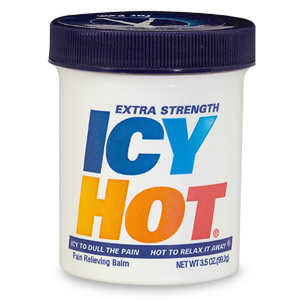
So imagine my surprise when I discovered that people were drinking
aloe vera juice. Now, drinking "enhanced" beverages is nothing new;
VitaminWater's annual earnings could probably feed a medium-sized
continent for a year. And once the American public latches onto the
smallest scrap of health advice, no matter how incorrectly used, they
can't get enough.
Just over five years ago, Pom Wonderful was a niche product. It was
familiar mostly to those who really displayed an interest in nutrition,
or at least looked at the ads in Men's Health that don't inexplicably
have guys just lounging in their underwear together. Now everything is
pomegranate flavored, from ice pops to Smirnoff vodka.

After contemplating this, the idea of drinking aloe vera didn't really
shock me. But the concept still disgusted me. I imagined it to have a
creepy, "slick" texture. Like an awkward medium between the silkiness of
Fiji water and a glass of warm pan drippings.
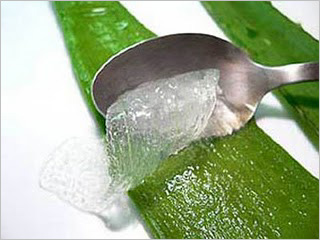
As a bit of a health nut myself, I figured it was a good experiment to
try. If I wound up hating it, I would at least have a story to tell. If
it turned out to be delicious, I could use its nutrients to balance out
the Taco Bell I had for lunch. The only way to find out whether a
liquidized aloe concoction would land on the delicious or disgusting
side of the fence would be to find out for myself.
As a benefit to my finances, my local supermarket had recently
experimented with selling these products. That experiment appeared to be
a massive failure, so I was able to buy a can for twenty two cents.
The can sat in my cabinet, then eventually my fridge ... taunting me.
I feared what it would taste like, but I had to know. Eventually, I was
able to gather up my courage, and attempt to dig in. Oh God, I hope I
wouldn't actually be digging in. I hadn't even contemplated the
possibility of solids floating in it. It would be some bastard
spawn of "homestyle" orange juice and
Orbitz.
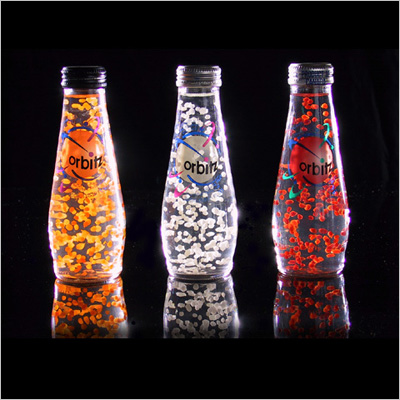
Upon taking a closer look at the can, I realized there would indeed be
solids. The can says "Bits of Real Aloe," like that's a selling point.
I'm drinking this to be healthy; I just want to get it over with and
don't want to chew my beverage. If I drank wheatgrass to be healthy (I
don't), I just want to drink it. I don't want "Real Wheatgrass
Clippings" floating about.
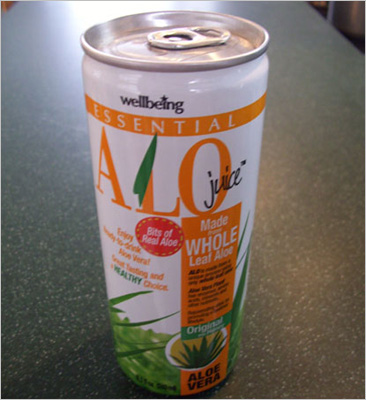
I didn't think it would be carbonated, but with a drink this bizarre,
who knows? At the same time, I didn't want all the "Real Bits of Aloe"
staying in a gelatinous clump. So I used my years of Yoo-Hoo training,
and gently shook the can ... then poured.
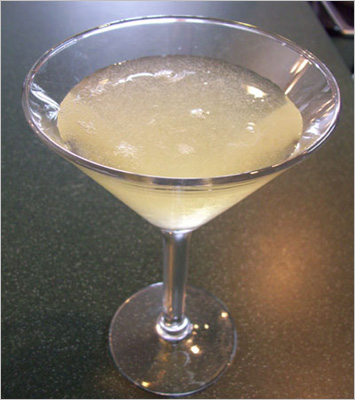
The first thing that struck me was that it smelled pretty good.
The appearance, on the other hand, was an off-putting, translucent,
mucous-esque slime.
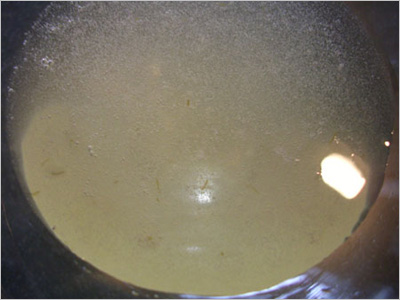
There they are: the "Real Bits of Aloe." (I wonder if imitation
aloe bits are more aesthetically pleasing than real bits.) When
looking straight down into the glass, it had an alarming similarity to a
petri dish filled with bacteria.
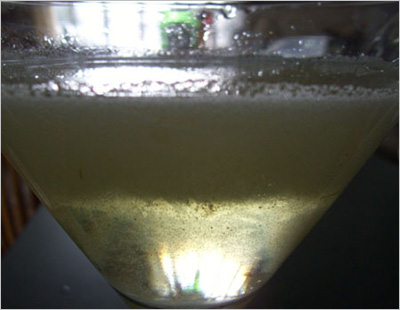
Possibly more upsetting than the top-down perspective was looking at it
from the side. The liquid and solids had clearly separated, and it bore
a close resemblance to Jell-O 1-2-3.
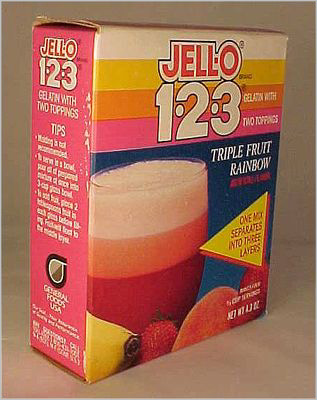
The visuals were as creepy as I was expecting. All that was left now was
to see if the taste was more or somehow less appealing. Upon first sip,
I was extremely disappointed. It was actually kind of ... good!
Well, small parts were. And by small parts I don't mean "Real Bits of
Aloe."
If you manage to get a sip with no solids in it, it was similar to a
thinned-out pear nectar. But a bigger sip opened the floodgates for the
bits of aloe (real bits, by the way) to come rushing in. Bouncing off my
teeth and touching my tongue in a most unsettling way. In that instant
the aloe juice went from mildly enjoyable to incredibly horrifying.
If you're a fan of the aforementioned Orbitz, or bubble tea, you might
be able to get into aloe vera juice. For me, liquid and phlegm blobs
don't go well together. Separately, they're great.
By this point, I'm sure you're thinking, "This sounds delicious and all,
but are there any benefits to aloe vera juice that might make a good
sidebar for an article in Prevention magazine?"
I'm glad I made up that you asked, because we are about to find out how
well aloe vera juice compares to aloe vera gel when it
comes to soothing a burn inside your mouth.
Now I was going to step it up, comparing the results of aloe vera
juice with aloe vera gel in treating burns inside your
mouth.
Chances are you have a bottle of aloe gel left over from the last time
you got sunburned. Sure, aloe soothes burns on the exterior of your body
-- but is it effective if the burn is inside you?
Before beginning this process, I should point out that ingesting aloe
vera gel can be poisonous. The label reads that if you accidentally
ingest any, you should call a poison control center. They don't say what
you should do if you intentionally ingest it, but we can assume
they would still advise calling a poison control center.
I don't know if the poison levels are on par with cyanide, or if this is
just standard text used as legal protection, like when they tell you to
call poison control if you swallow a Band-Aid. In either case, I don't
feel like finding out. So the aloe gel used in this test will be spit
out and rinsed.
If I'm going to intentionally burn my mouth, I'm going to do it safely.
Test #1: Scalding Water
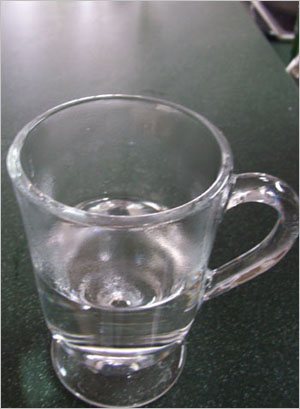
We will be testing burn relief in two ways: literal and
metaphorical heat. The literal heat comes from a cup of near-boiling
water. Hot enough to be painful, not hot enough to actually require a
trip to the hospital.

One big sip and five painful seconds of waiting later, it was time to
test the relief. The aloe vera juice did a terrible job -- it was
about as soothing as any cold water or juice.
After waiting a little while to allow my mouth to calm down, I re-heated
the water and took swig number two. This time, we will test the
effectiveness of the aloe vera gel. One teaspoon of the green
slime was used to coat my mouth and tongue (being careful to avoid
ingesting, be it accidentally or on purpose).
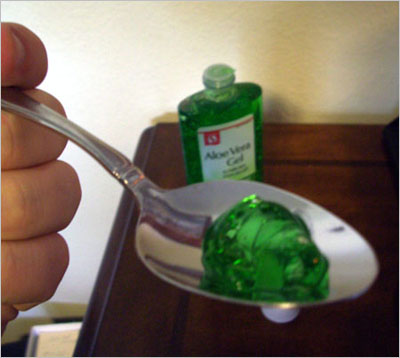
My initial reaction was one of surprise -– after about a minute or so,
it actually was doing a pretty good job of relieving the pain. However,
when I looked at the gel's bottle, I figured out why. The aloe vera gel
wasn't 100% aloe vera, it also contained Lidocaine, a numbing agent.
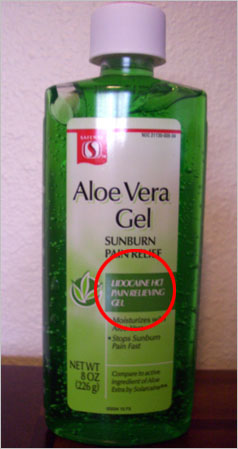
So while I will give the edge to the gel in this instance, it did have
some big help from its chemical partner.
After rinsing with Listerine, I discovered that my mouth was still a bit
numb, and would continue to be like this for about fifteen minutes. Once
my pain receptors regained consciousness, it was time for the next heat
test.
Test #2: Hot Sauce
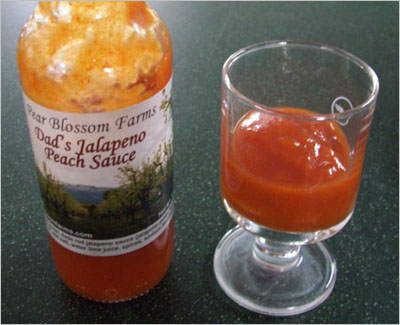
This isn't the hottest sauce out there by any means, but since a little
goes a long way, I figured four huge tablespoons would go a very
long way.
I tried to do the sauce in one shot, but since it had a creepy, thick
consistency, it required the use of fingers the get it all out. It
certainly wasn't the hot sauce-swigging tough guy image I was hoping
for.
For the aloe vera juice, you will know how its healing
effectiveness felt. The last time you reached for some water, thinking
it would help with something spicy (it won't), this was the same
feeling. I'm beginning to think burn relief wasn't one of their main
priorities when creating this beverage.
After refilling the glass with hot sauce and re-emptying it (with
fingers, again) into my mouth it was time to test the aloe vera gel.
The positive is that the gel did indeed help soothe the burn, although
again I assume that's the Lidocaine talking. The downside was that the
taste of aloe vera gel, Lidocaine, peach, and hot peppers mixes as well
as you would imagine.
As I contemplated whether this research should be submitted to various
medical journals, I prepared for my final test. Let's wash that
horrifying taste out with some booze!
Since I have been referring to aloe vera juice as a health drink, it
might actually be a good idea to mention what those health benefits are.
According to the company who makes the juice, aloe "helps increase the
immune system" and "cleanses the colon." So that's pretty exciting.
According to their Web site:
"It is also said that Aloe Juice could benefit a
person with intestinal or stomach problems. It should aid in the healing
of ulcers and help the digestive tract to work smoothly. It is also said
that this health drink can improve circulation."
And since each of those claims is prefaced by "It is also said" or "It
should," we can assume those claims are entirely false, or just guesses.
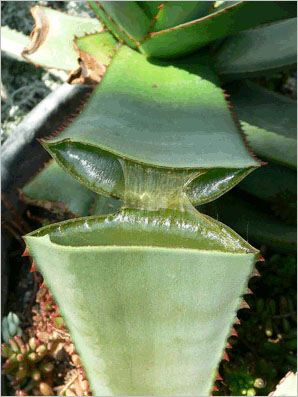
Anyway, health benefits are great and all, but it would be far more
interesting to dilute those health benefits with alcohol!
The next time you have friends over for drinks, and they are talking
your ear off about drinking red wine for the heart or beer for the
prostate, feel free to ignore them (like you probably already do).
Instead, offer them some party-starting cocktails that get their
digestive systems running more smoothly than ever.
No one will want to try them. Let's be honest, it's a pretty disgusting
concept. So in order to up the interest level, you need to resort to one
of the tricks of the trade used in more upscale restaurants, like
Applebee's: themes!
Like most people, I associate aloe primarily with being burned. And
since I had just burned my mouth with hot sauce, I thought, "What a
great combination!"
Combining my porphyria-like results from sun exposure, the cooling
effects of aloe, and some traditional beach alcohol, we have:
"Man With Dominant Irish Genes Goes to
Mexico"
2 parts Aloe Vera Juice
2 parts Tequila
1 part Hot Sauce
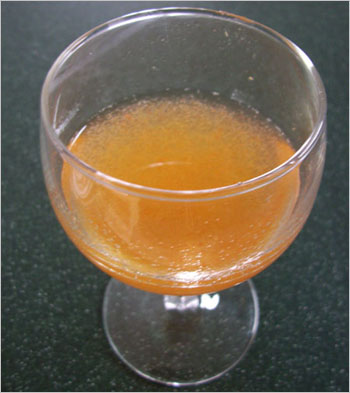
Surprisingly, this turned out pretty well. Its biggest fault is the
presence of those pesky bits of real aloe. Besides their unwelcome
intrusion, the sweet and spicy combination balanced fairly well. And as
an added bit of authenticity, if you drink too many of these, the hot
sauce is sure to give you a terrible stomachache, similar to drinking
Mexican water.
Of course, spicy drinks aren't for everyone. Some people prefer the
sweet beverages. The following drink isn't my cup of alcoholic tea, but
as any good bartender knows, you've got to make what the people want.
"Generic Drink Loud Girls Order When They're
Not Yelling WHOOO!"
2 parts Aloe Vera Juice
1 part Jagermeister
1 part Caramel Sauce
7 Maraschino Cherries
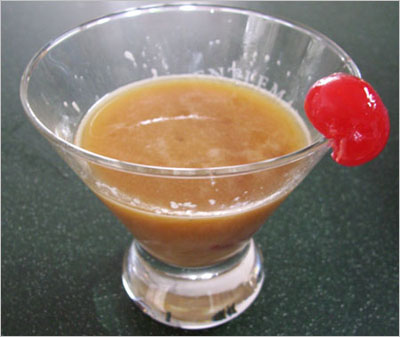
Unfortunately, I did not have sour mix available, which is the mixer of
choice for these types of drinks. So I substituted caramel sauce, since
I figured it brought a similar amount of horrifying sweetness to the
party. It has the inexplicably popular Jagermeister because that's a
popular alcohol for these types of drinks. Finally, copious amounts of
maraschino cherries ... of course.
And as an added bit of authenticity for this drink, the beverage
itself looks like what happens if you drink Mexican water.
For the final drink, we steer it over to the healthy aspects of aloe
vera. As I mentioned, pomegranate enjoyed a huge rush of popularity when
people figured out that even if something is 100% sugar but is flavored
vaguely similar to pomegranate, it would sell like crazy.
Lately, pomegranate has had a lot of its thunder stolen by the acai
berry. This is another "superfruit" that legitimately does have a lot of
benefits, which are mostly lost when "Acai Flavored" food and beverages
are made.
The logic here is that if you combined the acai berry with aloe vera
juice, you could possibly make the most healthy beverage ever created.
Also, it could get you drunk! Most importantly, it has what
casual restaurants consider to be the most important part of a cocktail:
a terrible pun in the name that doesn't really make any sense and is
only there to sound clever.
"Last Night I Dreamt That Someberry Loved Me"
2 parts Aloe Vera Juice
2 parts Acai Berry Juice (or something flavored with it)
2 parts Vodka
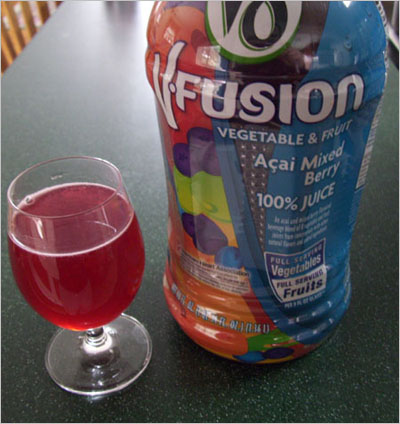
I'm not going to lie and say it was "too sweet" in an attempt to sound
manly or like a true connoisseur of alcohol ... this was good.
What would make this even better would be to use some cheesecloth to
filter out the aloe pieces. If those horrifying little sea monkeys were
to be removed, this drink would be downright awesome.
Now that I have dealt with globs of slime, a scalded mouth, and
plant-related inebriation, it can be officially declared: aloe vera
juice is stupid. If you want a cleansed colon that badly, use some
Pledge. And if you're that intent on having a great immune system, just
increase your Vitamin C intake the way most Americans get their daily
recommended amount: Fruit Roll Ups.
|


















